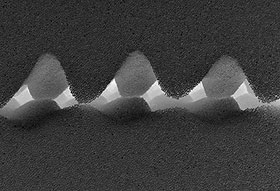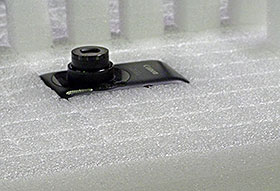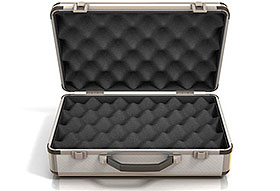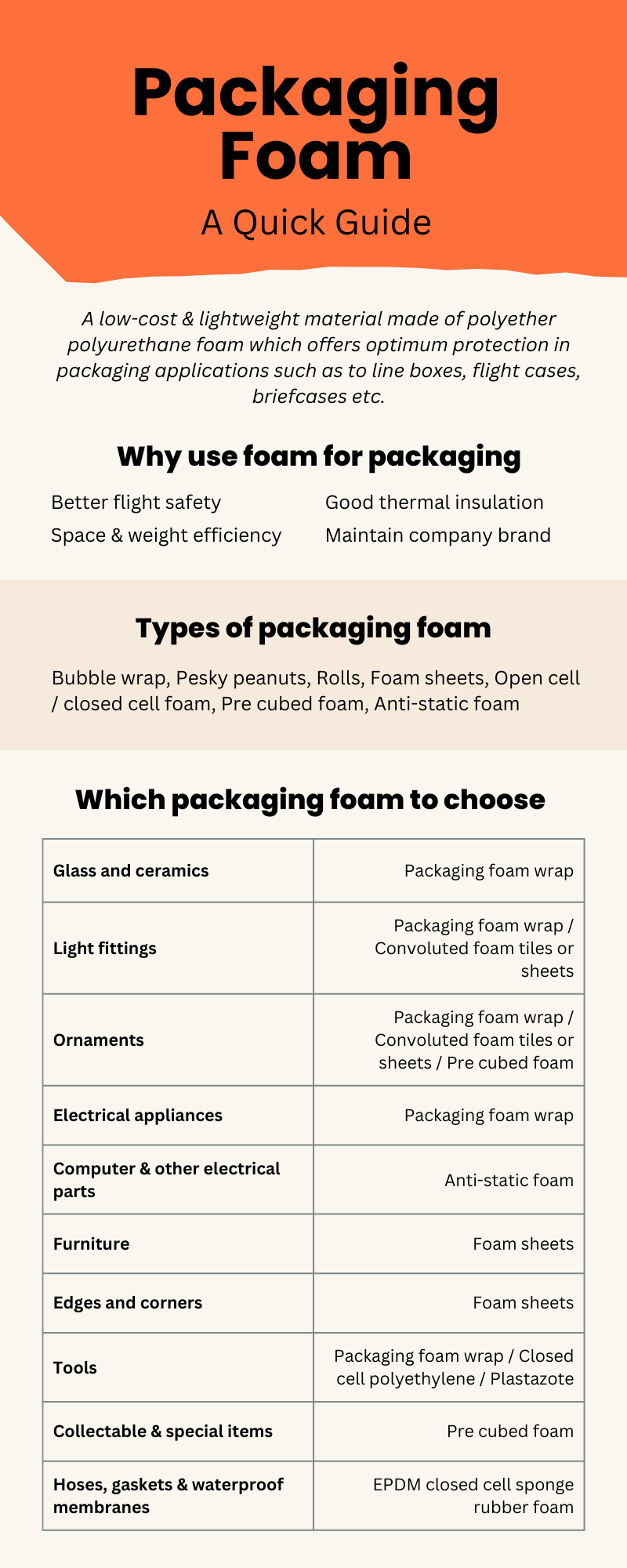
Quick Guide to Packaging Foam

It can be expensive if your products become damaged during shipment. There are many different ways manufacturers can keep their packages protected. Packaging foam ensures excellent protection. Due to the recent COVID-19 crisis, many consumers are turning to online transactions, so it’s even more important to use high-quality foam to protect products against severe falls and bumps.
Why use foam for packaging?
Here are top 4 reasons for using foam for packaging applications:
Better Flight Safety: Flight safety regulations are stringent and packaging foam can ensure better safety. Damaged packaging may be potentially risky during flight. In certain cases, important fluid-based products may not be transported by air. Flight cases with packaging foam protection can prevent spills. eFoam can provide packaging foam cut to size to match the dimension of the products and flight cases.
Space and Weight Efficiency: When transporting products in cardboard boxes with aeroplanes, space and weight efficiency is an important consideration. Compared to other protective applications, like wood crates, packaging foam saves space and is much lighter. It’s easy to cut packaging foam to ensure that it remains compact. Even if the packaging foam is bulky, the overall weight will remain low, ensuring tremendous cost savings.
Good Thermal Insulation: Certain products are sensitive to thermal fluctuations. Heat is transferred through radiation, convection, or conduction. High or sub-zero temperatures can cause damage to delicate electronics. Closed cell foams are excellent packaging foam materials to maintain thermal insulation.
Maintain Company Brand: Proper use of packaging foam can be beneficial to your brand. When customers unbox the products, they will be glad to see the excellent protection provided by the packaging foam.
What is packaging foam?
Packaging foam is a polyether polyurethane foam which offers optimum protection in packaging applications such as to line boxes, flight cases, briefcases etc. with thinner types of foam being suitable for wrapping objects.
It’s a low-cost & lightweight material, thus keeping shipping costs to a minimum. It’s easy for businesses to impress customers without spending much money. Reliable shipments will ensure repeat purchases, because customers are confident that their products will be kept protected. Optionally, packaging foam can be customised with unique logos, colours and shape to match the company’s brand.
Types of packaging applications
Bubble wrap
Bubble Wrap is what people usually think of when thinking of packaging fragile items, and indeed the large air bubbles in the bubble wrap are a great way to protect some fragile items, e.g. if you are moving house and packing up all your cups, glasses, etc. Foam however is more suitable for fragile items that would benefit from being packed more securely and tightly, e.g. electronics, screens, and cameras. Packaging foam has the added advantage of being thermal insulating and anti-static (depending on type).

Pesky Peanuts
Another typical packing application are those annoying little foam pieces known as peanuts due to their shape. As most people know, these have a tendency to spill everywhere making a mess and are especially not great to have around if you have curious pets or young children.
Packaging foam offers a much tidier solution and can be found in a variety of useful formats:
Rolls - example
You can get rolls of thin closed cell foam (closed cell foam is foam where the air bubbles or cells are intact so the gas cannot escape) for a variety of packaging applications. This type of foam can be wrapped around a variety of objects and will conform well to all sorts of shapes. It also has the advantage of being water resistant. It can be used multiple times and then recycled and comes in various thicknesses from 1mm to 4mm.
Sheets - example
An array of foam types are available in sheets of various sizes, foam can be flat or convoluted (the "egg crate" style that looks like acoustic foam) and can be open cell or closed cell.
Open cell / closed cell
With open cell foam, the tiny air bubbles (cells) are broken, which allows air to flow freely in and out of the cells. This type of foam tends to feel softer more flexible. With closed cell foam, the cells are not broken, so air trapped inside them cannot escape. This type of foam feels more rigid and has a higher resistance (R) rating. An advantage of this type of foam is that it can be water and vapour resistant.

Pre Cubed Foam - example
Pre Cubed foam is ideal for packaging equipment securely into carry cases. The foam is pre-cut into a grid pattern, so the user can easily remove plugs according the size of item that needs to be packaged. This makes it easier to pack items that are irregularly shaped as well as fragile (e.g. cameras and similar equipment).
Here is a video showing how to use pre cubed foam in a case: https://www.youtube.com/watch?v=kW20t41s824
If you don't have pins around, you can also use chalk to mark out your shapes.
Anti-static - example
If you have static sensitive objects to pack (such as circuit boards, computer chips and other components), this type of foam will provide protection from electro static discharge as well as providing the advantages of regular foam.
How to choose packaging foam?
If you are moving house, office or simply sending items, foam can be a great addition to your packing supplies. Here are some suggestions for how and when to use different types of packaging foam.
Glass and ceramics Packaging foam wrap is an obvious choice here, it can be purchased in rolls, is less bulky than bubble wrap and can be cut easily to your preferred shape with scissors, so when you are moving house you can easily wrap individual items for packing.
Light fittings Light fittings can be fiddly, wrapping them in packaging foam wrap can protect them during a move. You could also use convoluted foam tiles or convoluted sheets as the convoluted shape will help protect delicate fittings.
Ornaments Larger ornaments can be wrapped in packaging foam wrap, smaller ones could be packed between sheets/tiles of convoluted foam. For very special and valuable items, we recommend taking the time to pack them in 'pre cubed' foam.
Electrical appliances Modern electrical appliances are usually fairly sturdy (unless they have glass components such as blender jugs) but you'll still want to protect them from scratches, bumps and accidental breakage. Foam packaging wrap may be enough, but for more delicate appliances, thicker foam sheeting may be better.
Computer and other electrical parts (e.g. circuit boards) These are definitely candidates for anti-static foam (which is pink to differentiate it from other foam types) and/or ethafoam, as delicate components such as these need to be protected from electrostatic charges that can build up in these components. These foam types are available in various thicknesses and are also moisture and chemical resistant.
Furniture Foam sheets come in various thicknesses so can be helpful in protecting furniture from bumps and scratches.

Edges and corners You can cut up strips or wedges of packaging foam sheeting to protect furniture edges and corners of furniture and fittings (just stick them on with masking tape). Not only will this protect the items, but it will protect your movers from accidental injuries and cuts on sharp edges (e.g. edges of mirrors).
Tools Different types of foam can be used to pack tools, depending on the size and nature of the tools. Small tools can be wrapped in foam wrap. You may want to wrap larger tools in thicker foam sheeting or use a sturdier type such as closed cell polyethylene or Plastazote, particularly if there are sharp blades that need covering.
Collectable and special items For collectable and special items such as models and figurines 'pre cubed' foam is ideal. If you have very special items, you may even want to invest in a case which you can fill with pre cubed foam. To customise your 'pre cubed' foam we recommend using toothpicks to mark out your shapes.
Hoses, Gaskets & Waterproof membranes EPDM closed cell sponge rubber foam is primarily used in the Automotive & Construction industries. Typical applications include custom made specialist items such as coils, seals, waterproof membranes, hoses and gaskets. EPDM foam rubber is available in sheets and cut to size, in many thicknesses. It can also be supplied with or without a self adhesive backing.
To learn more benefits of using packaging foam for protective packaging applications, contact our friendly advisors today.


